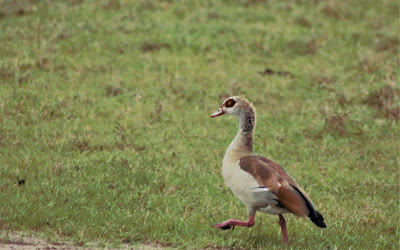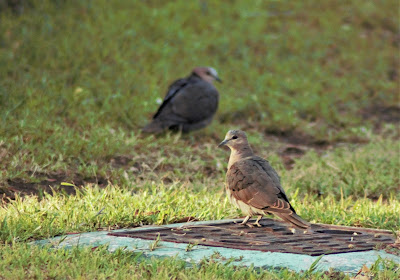Our Cabin :).
We had less than 24 hours at Sweetwaters before starting the long trip south so I had to get out and abut quickly to try get to see some birds. Happily that did not prove to be very difficult. The afternoon after arrival we headed out on a safari around the national park which was wonderful and the 5am start to get to see some birds before departure was great too. Sweetwaters is located on the North west side of Mount Kenya and has some very different habitats, here it is very green and animals we saw were well fed and healthy. There are a lot of Rhino in the park and even more rangers about to look after them.
The Greater Blue Eared Starling was pretty common around the this area, a very beautiful bird.
All over the country you come across the Superb Starling but it never grows old, they are stunning little birds.
I think this is the endemic White Bellied Canary but got very poor views and only this shot so cannot be certain.
I spotted this little Cardinal Woodpecker scurrying up the tree and managed to get one clear shot before he vanished. These are relatively common around NE Africa and have a distinctive Black Moustachial Stripe.
The Eastern Black Headed Oriole is, I think you'll agree, is a lovely bird.
Perched on a tree and making quick forays to the ground was this Southern Black Flycatcher. A very pretty bird despite being mono coloured :).
A Northern Black Flycatcher, very similar to the southern but has a matt plumage and juveniles have a browner colour. I am thinking this is a juvenile moulting to adult plumage.
Red Cheeked Cordonbleu, without the red cheeks. This species is common across Africa, the female does not have the red cheeks.But the male does. These two were busily feeding on the lawn close by our tent.
A pretty rough looking Dove which I think is one of the Turtle / Collared Doves but can't really work out exactly which. Any good ideas out there?
The White Browed Sparrow Weavers were very common around the area. Very strikingly patterned but tend to be found in small groups.
Dark Lored Babblers are endemic to East Aftica. As with most Babblers this one was in a small group which if anything like those encountered in Arabia are a small family group.
The Blacksmith Lapwing was not particularly easy to photograph because it never came near to vehicles at all but its a pretty distinctive bird anyhow do reasonably easy to identify even at a distance.
A nice shot of a Kenya Rufus Sparrow one of the countries endemic species. These are a bit larger than our sparrows but are very similar in habits.
The Crowned Lapwing was fairly common out in the open areas of the park, however unlike many waders it is not generally associated with water.
I will admit to being in two minds about this one as the photo is not perfect, however I am reasonably happy with Black-Winged Lapwing because of the darker band at the base of the bib. The other one it might be is the Senegal Lapwing but the more I look at it the more I doubt it. :)
Female Common Ostrich seen while out touring around the park, we also saw a male but at considerable distance.
Egyptian Goose were everywhere, or at least everywhere we had visited so far.
Just wandering back from looking at a blind Rhino when I spotted this Wire tailed Swallow perched on a gutter. It was getting late and cool so I guess he was getting settled down for the night.
Just after dawn I came across this White Bellied Go-away-Bird which is another endemic to NE Africa. These are fairly large birds yet pretty adept at remaining hidden from view when they want to.
Believe it or not I was very happy with this photo of 4 African Sacred Ibis flying in the distance. Ok so not exactly an award winning photo but hell it was taken from the back of a moving car on a very bouncy piece of road :).
Another spur of the moment shot, I heard this Meyer's (Brown) Parrot in the trees above but could not get a clear view until this one clear shot. They are the most widespread of the Brown Parrot superspecies complex. What a delight though eh?
One of the Wood Doves but I have not been able to get any closer in my ID than that from the photo
Virtually everywhere we went the Pied Crows were about, generally in small numbers but always there.
With moments left before we had to set off I spotted this lovely White Browed Coucal in this bush by the entrance to the estate. Result :) !!
Not got a clue at the moment, will update if I find out what this is.
A nice little shot of mother and calf Rhino, but to be honest it was more to do with the Cattle Egret following them around, more mammal photos below :)These two were making a lot of noise in the tree above the car park, I am reliably informed that they are both immature Tawney Eagles.
A Rufus Chatterer, endemic to NE Africa, a really pretty mini babbler.
My idea of an "atmospheric" shot, i.e. too dark and blurred but taken of the waterhole at Sweetwaters and including a couple of Sandpipers.
Mammals
We had the opportunity to visit a Chimp sanctuary while we were at Sweetwaters. This is run with the Jane Goodall Institute and all of the 30+ Chimps on site are rescued from all across the world. They have this enclosure which is about a mile square in which to live out their days, the habitat is scrub and wooded with a river and small island. There is no real way to know if they are happy or not but its certainly better for them than being kept in a tiny cage.
A few more of our close relatives at the sanctuary.
Eland are among the largest of the Antelopes weighing almost a ton.
A wandering Water Buffalo crossing the road ahead of us.
A Lion in the distance, shortly after this was taken another male came and sat behind this guy,
A Spotted Hyena in the scrub, I think this one was asleep and was startled by the car passing. I thought we would see more of these in Kenya but in all we only saw 2 individuals.
A couple of photos of a small heard of White Rhino on the plains in the Sweetwaters Parks. I understand that there may be some black Rhino about too but they are very rare. It is a pitiful thing that all around these animals are heavily armed guards, and all because some halfwits think it makes their little thingies bigger!!
A heard of Plains Zebra grazing in the park.
An Elephant I think ;))
The name was given to this Rhino in honour of a past American President who seems to be the focus of the current American President.
Baraka on his way over to meet with us. The black Rhino are a little smaller than the white but when your up close and personal they are still pretty big. This guy lives in a special 300 acre reserve within the park and is semi tame, Rhinos do not have the best eyesight anyhow so being blind is not quite the handicap it may at first seem, that said there is no way I would be where that guy is at the moment.
Our visit to Sweetwaters was very brief but it will remain in my memory forever. Definitely worth a visit and if you are looking for somewhere to support the associated charities are well worth considering.
© Bernard Bracken

















































